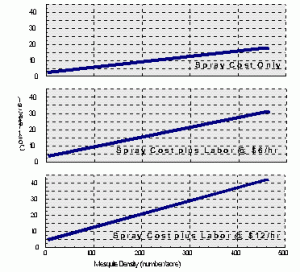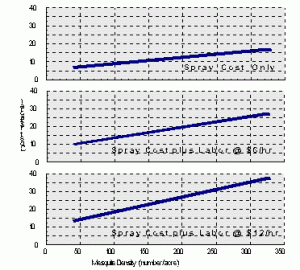Two simple methods for effectively controlling mesquite are described in L-5144, “Brush Busters: How to Beat Mesquite” (Texas Cooperative Extension). These methods are designed to control small mesquite before they mature, thicken and require expensive broadcast chemical or mechanical control methods. Brush Busters recommends only “select” treatments, which normally kill at least 7 out of 10 mesquite treated. The Brush Busters methods allow you to selectively eliminate the mesquite you don’t want, without damaging the plants you value. Brush Busters methods often are less expensive than broadcast chemical or mechanical control methods.
By following the simple directions that follow, you’ll be able to determine the density (abundance) of mesquite and then estimate the cost of controlling these plants with either of the two Brush Busters methods. Your actual costs may vary considerably from the estimate you develop using this brochure, depending upon the size of your plants, the efficiency of your workers, and the type of equipment used. Costs given for spray ingredients are 1999 retail prices. Labor is estimated at $6 or $12 per hour. The cost data were collected on rangelands infested with mesquite ranging from a few inches tall to more than 6 feet tall (average of 2 to 3 feet tall).
Step 1. Estimate mesquite density (number of plants per acre).
- Select a representative area in your pasture. Pick a landmark on the horizon or some object in the pasture and walk 363 feet (this is about 121 big steps) toward that landmark or object. Stop. (If large brush prevents seeing 363 feet or walking in a straight line, see below).
- Turn around and slowly return along a straight line to your starting point. As you proceed, count every mesquite rooted within 3 feet of your path (about an arm’s length on both your right and left sides).
- To calculate the number of mesquite per acre, multiply the number of mesquite counted along the line by 20. For example, if you counted eight plants, then the density is 160 plants per acre (8 x 20).
- Repeat this procedure in at least three more representative areas.
- Total the samples, then divide by the number of samples to calculate an average mesquite density for your pasture. This average will be the “plants/acre” value you will use in the Step #2. Example: If you had four estimates of 160, 100, 60 and 80 plants per acre, then your average plant density is 100 plants per acre ( 160+100+60+80=400; 400 divided by 4=100).
Note: An alternative method is to mark off a square area 66 feet ( about 22 big steps ) on a side. Count the number of small mesquite rooted in this area, then multiply the number by 10 to calculate the number of cedars per acre. Repeat this procedure in at least three more representative areas, then calculate the average mesquite density for your pasture.
Step 2. Use the graphs to estimate cost per acre.
- Find the appropriate figure below for the Brush Busters method you will use. (Figure 1 estimates costs for the leaf spray method and Figure 2 estimates costs for the stem spray method.) Each figure consists of three graphs. The upper graph shows cost of the spray only. The center graph shows total cost for spray plus labor at $6 per hour. The bottom graph shows total cost for spray plus labor at $12 per hour.
- Locate your average mesquite density (the average calculated in Step #1) on the lower, horizontal axis (density axis) of the appropriate chart for the method you choose and for your labor costs. Draw an imaginary line straight up from your average mesquite density to the center of the bold sloping line.
- From the point at which the imaginary vertical line intersects the bold sloping line, draw an imaginary, horizontal line to the vertical axis (cost axis) on the left side of the chart. Make a mark on the cost axis. This point is an estimate of what your cost per acre should be in $/acre. Example : If you have an average of 100 small mesquite plants per acre, you’re using the Brush Busters leaf spray method (see Fig. 1), and your labor cost is $6 per hour, then the estimated cost of treatment is about $9 per acre
Figure1. Costs for controlling various densities of small mesquite with the Brush Busters leaf spray method. Upper graph shows cost for the spray mix only. Middle graph shows total cost with labor at $6 per hour. Lower graph shows total cost with labor at $12 per hour.
Figure2. Costs for controlling various densities of small mesquite with the Brush Busters soil spot spray method. Upper graph shows cost for the spray mix only. Middle graph shows total cost with labor at $6 per hour. Lower graph shows total cost with labor at $12 per hour.
Keep these points in mind:
- If the estimated cost greatly exceeds $25 – $30 per acre, you may wish to consider alternative mesquite control methods such as broadcast herbicide application or mechanical treatment if the acreage and location of your mesquite infestation will permit the use of these methods.
- Mesquite size is a major factor affecting the cost of Brush Busters methods. Costs escalate rapidly as cedar size increases.
- Costs can escalate rapidly if you apply leaf or stem sprays using excessive pressure or nozzles with large orifices.
- Labor is usually a major component of total cost with Brush Busters methods. Costs escalate rapidly as hourly labor cost increases and when workers are inefficient in the use of their time.
- The cost of using the Brush Busters mesquite stem spray method will be much greater for treating mesquite plants with multiple stems (such as those that have been previously mowed or burned) than for plants with only one or two main stems.
- Follow direction in L-5144, “Brush Busters: How to Beat Mesquite,” very carefully.
- Mesquite control must be used in conjunction with proper stocking rate and livestock grazing management to realize the benefits of increased forage and livestock production.
| Figure 1 |
 |
| Figure 2 |
 |